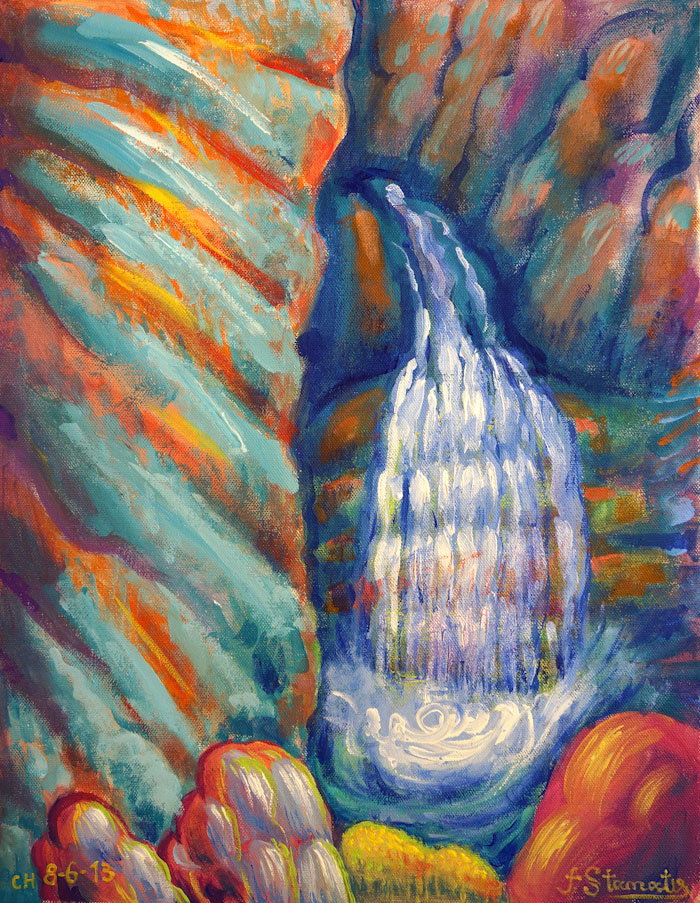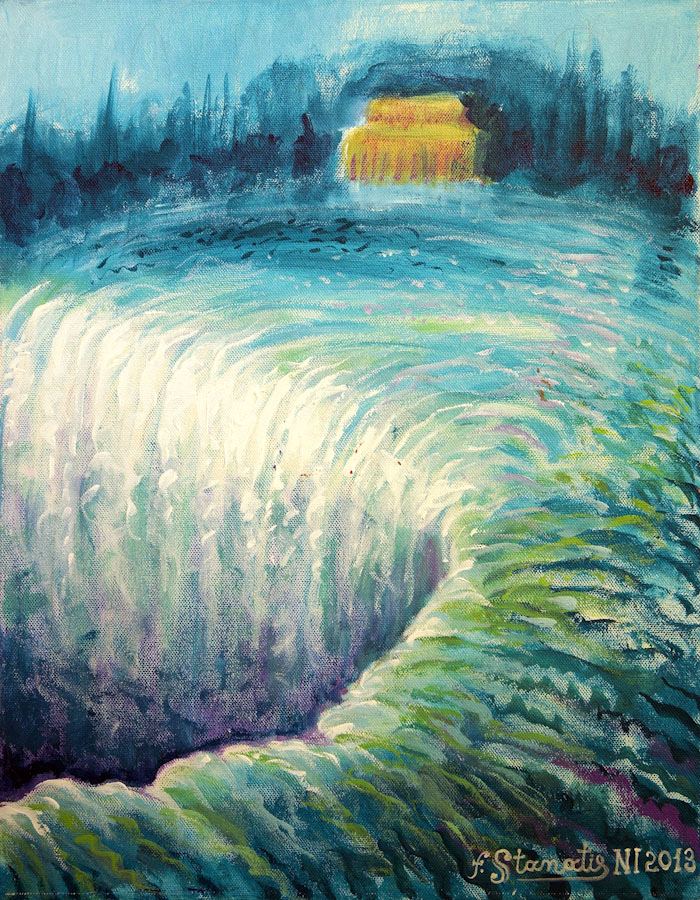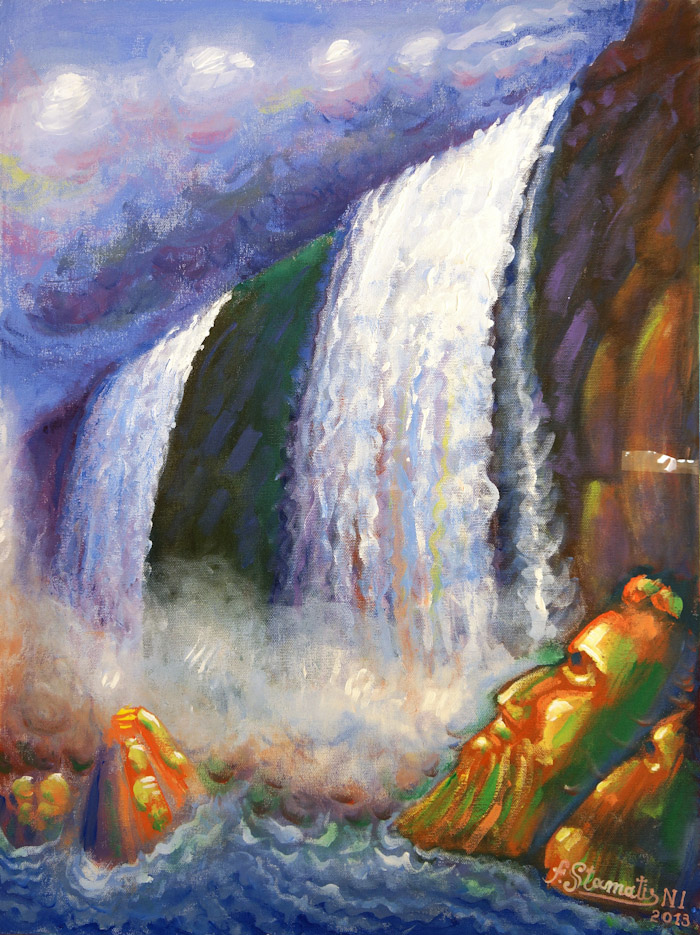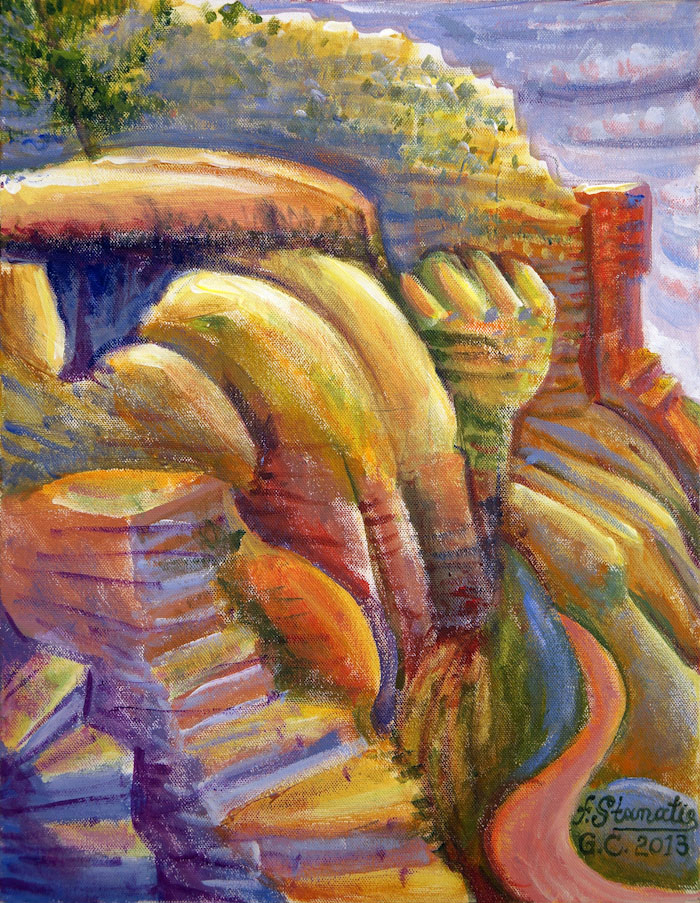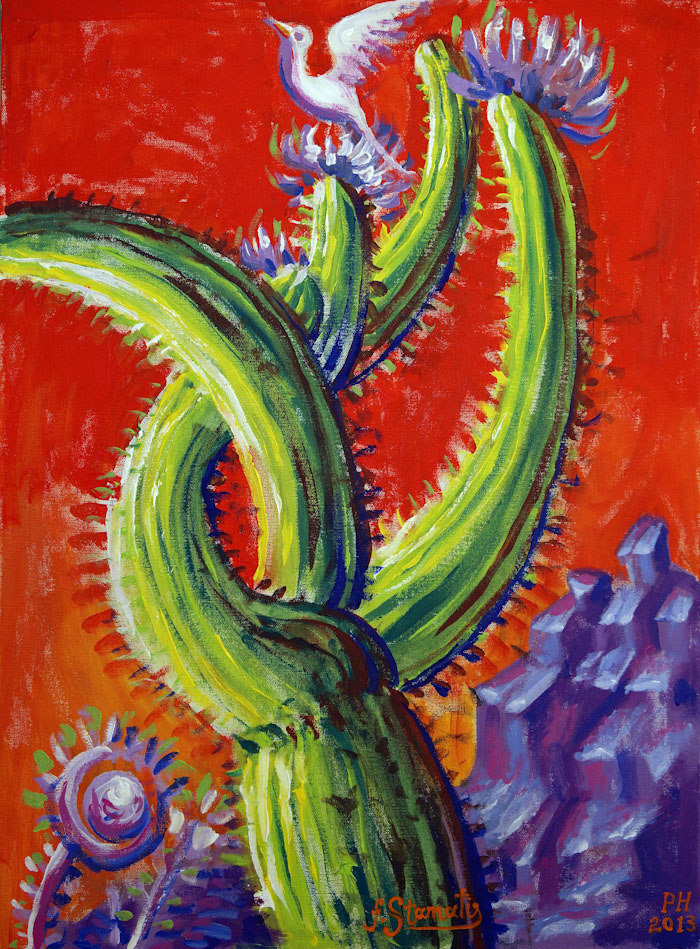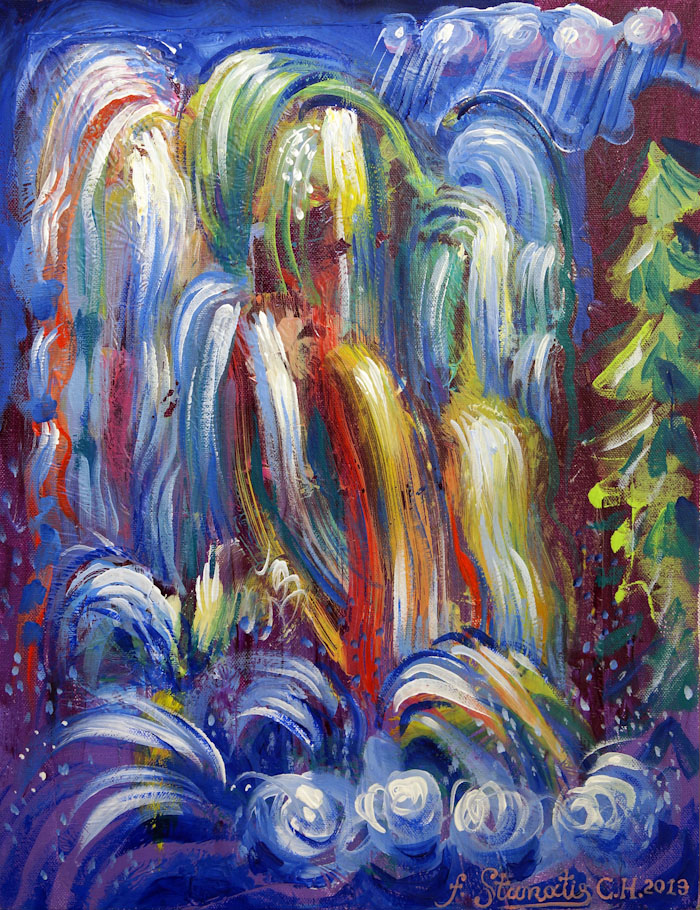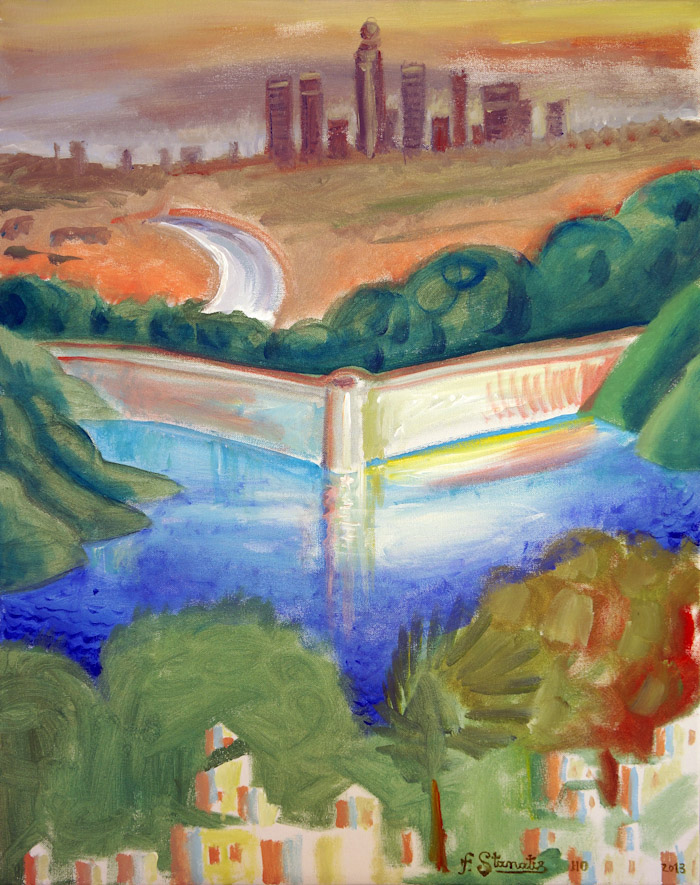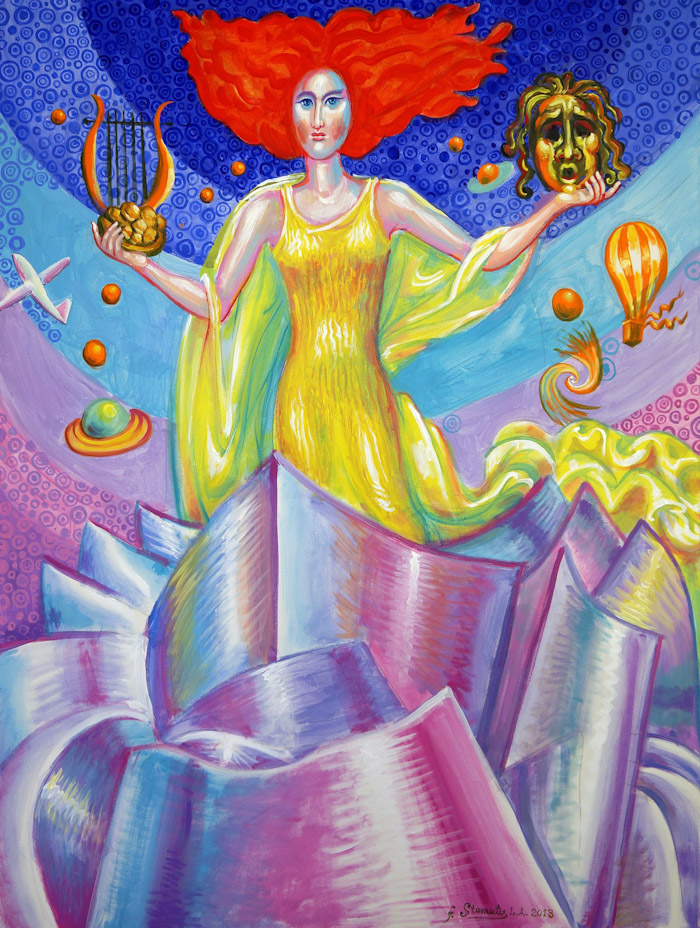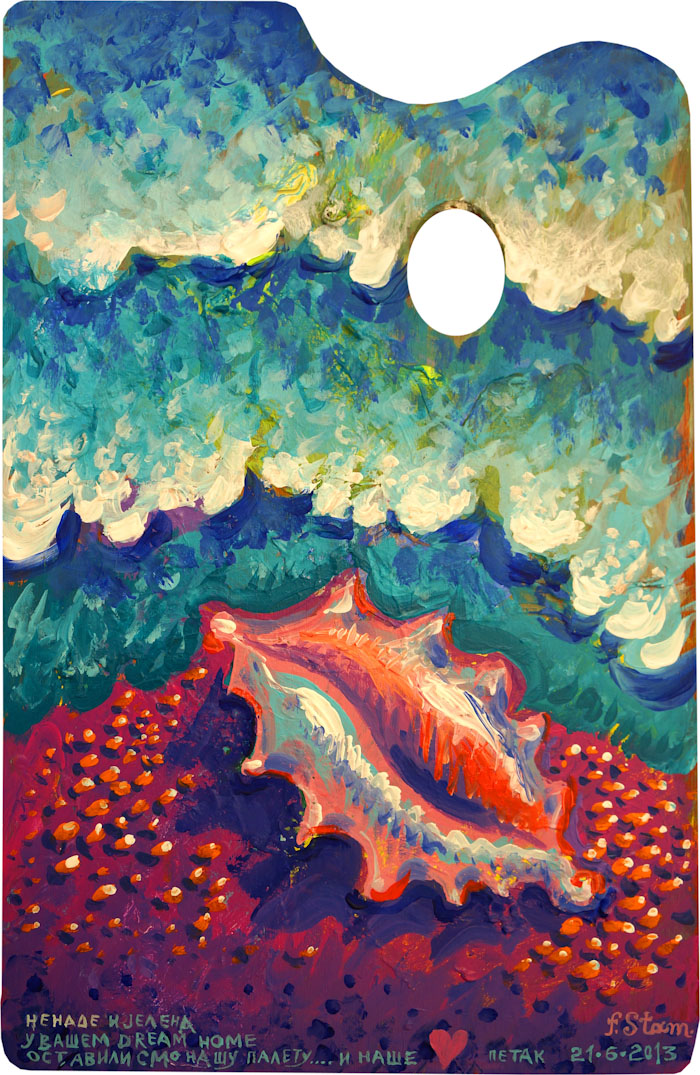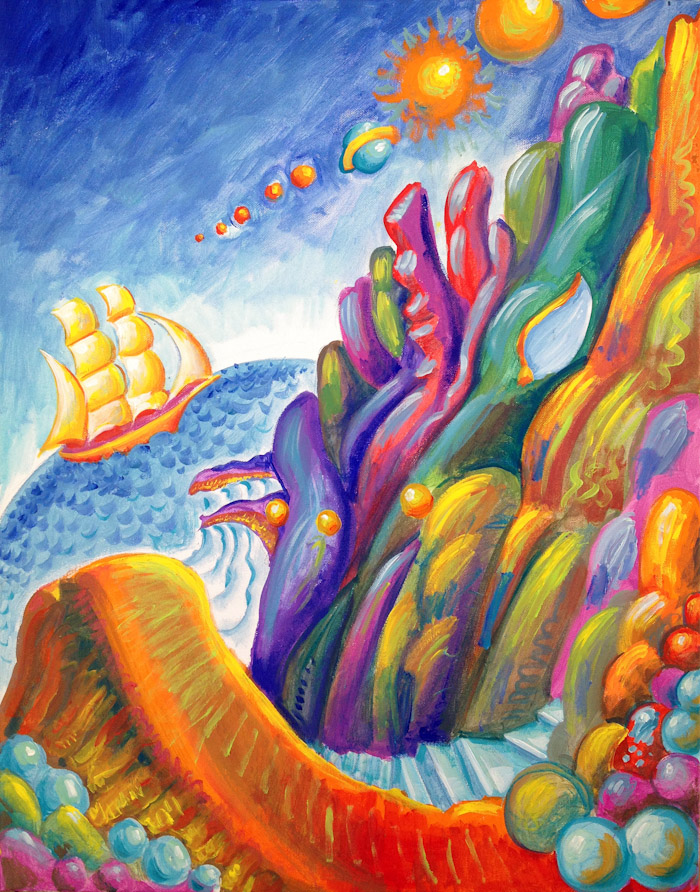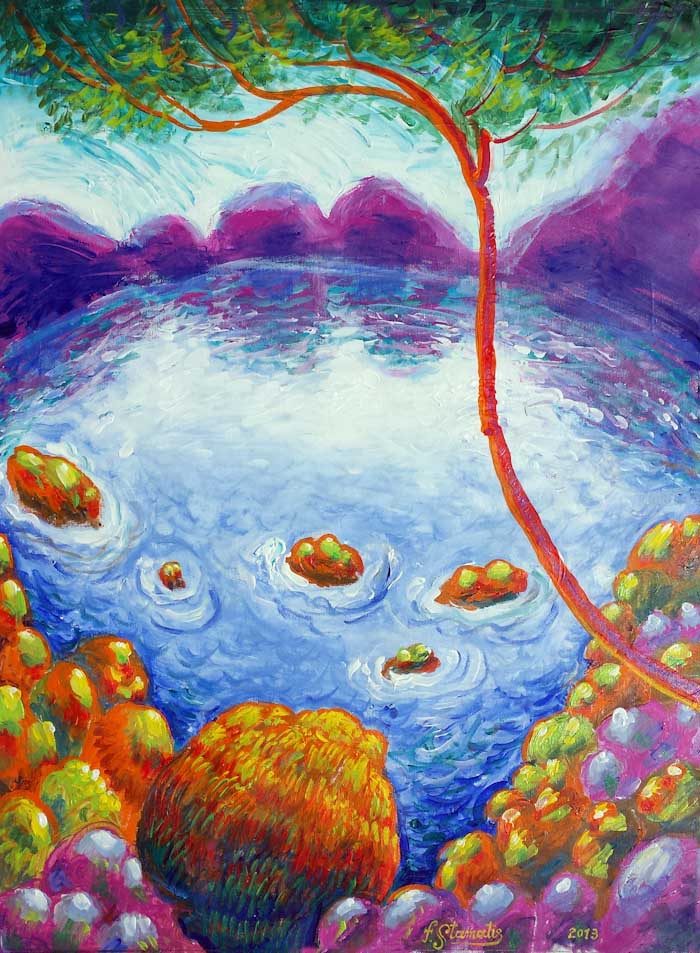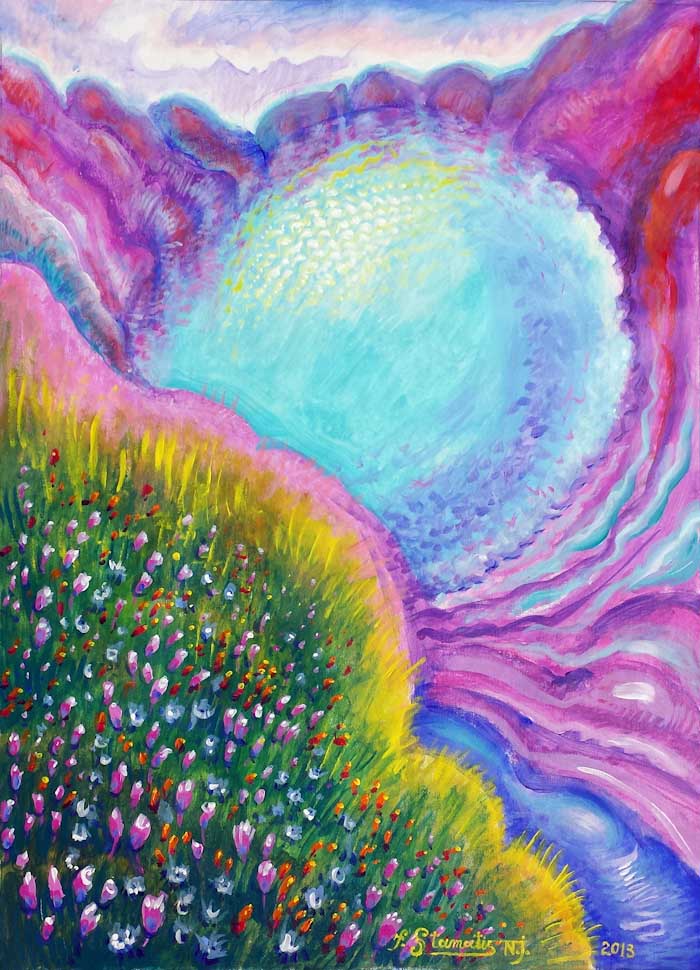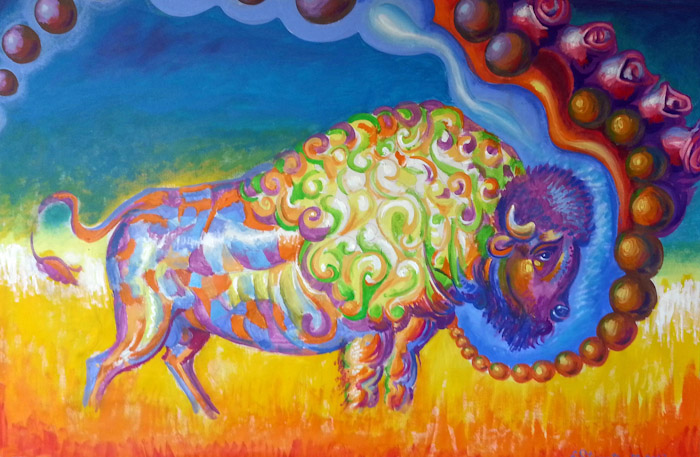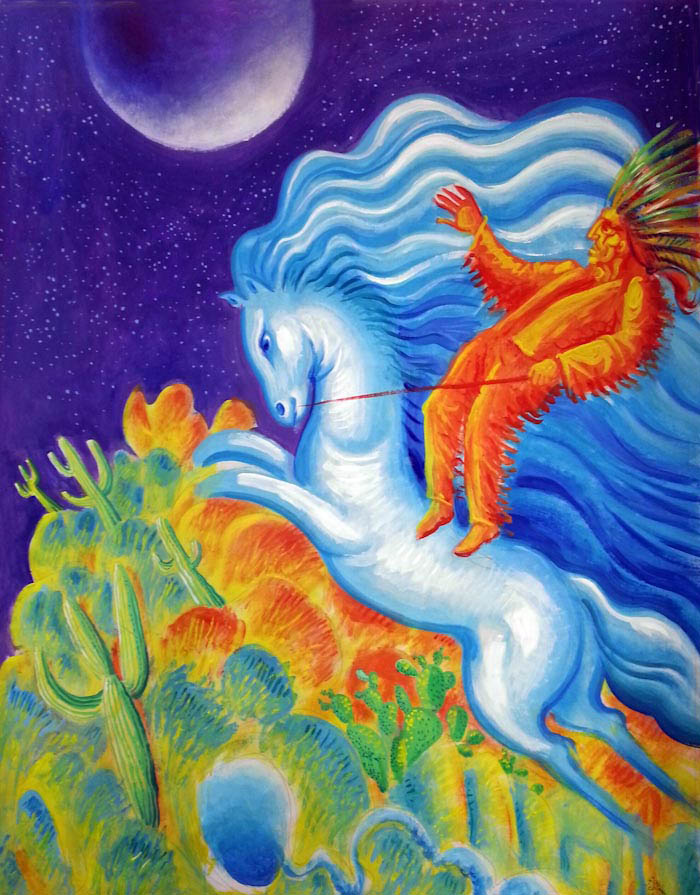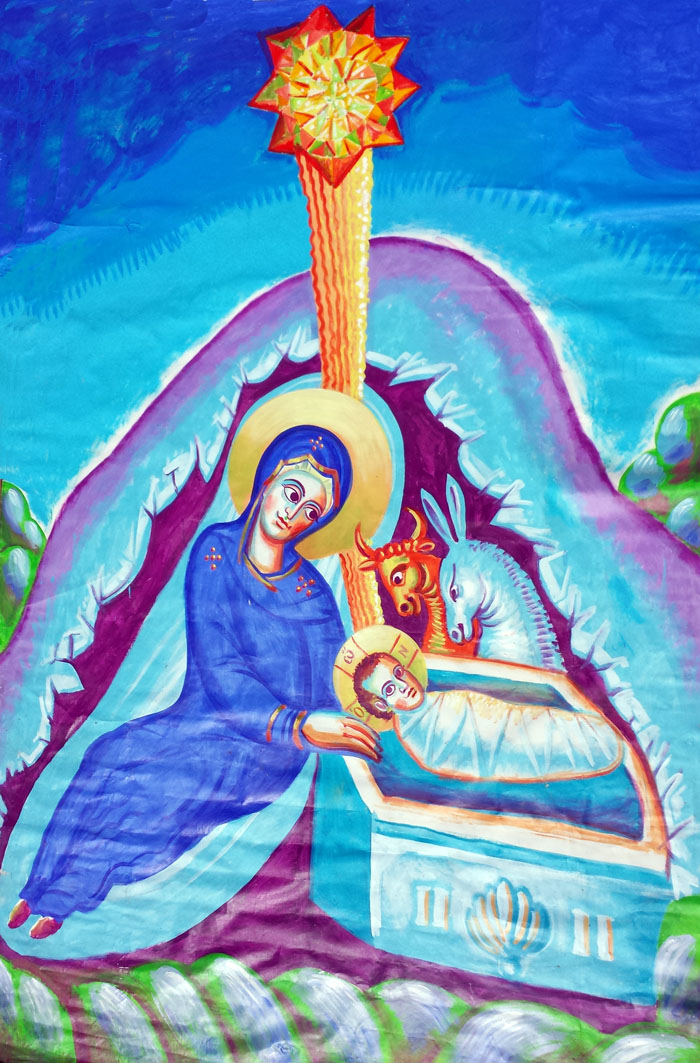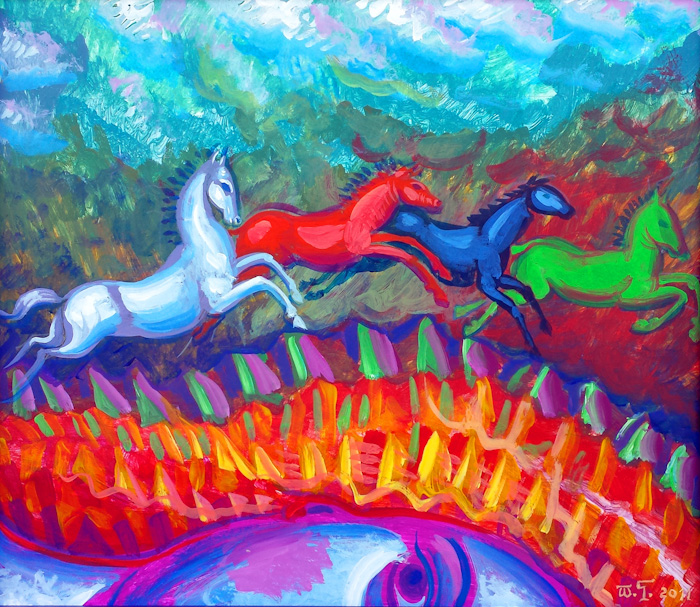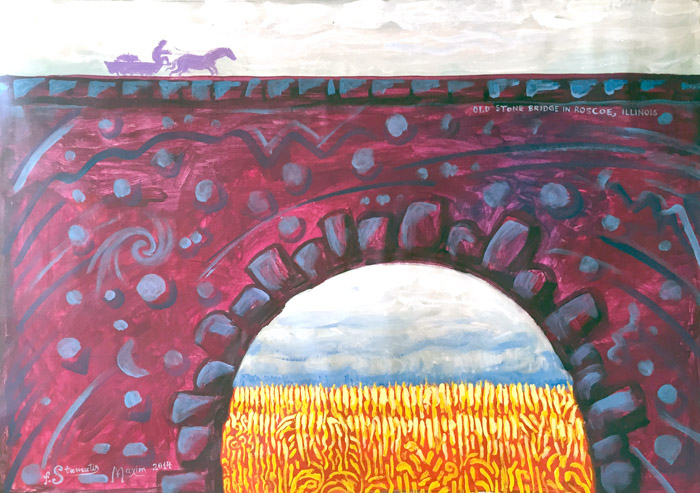A Marriage Of Byzantine Art With Our Postmodern Times - Making an Icon in a Postmodern Context
Performed by Fr Stamatis Skliris
Portrays and places of American landscapes arranged through Orthodox Iconography in an unprecedented way, blending the Byzantine tradition with influences of contemporary arts, paintings and images, creating exciting canvases that transport the viewer to new realms of delight and inspiration.
On the Changing Nature of Forms
Inspired by the painting of the National Parks of America
Fr Stamatis Skliris
We walk on the very crust of the earth. Beneath us, a seething hot sun is hidden in a damp fiery form. Landscape painting is the portrayal of this crust, since the painter's main concern is the rendering of three-dimensional space on a two-dimensional canvas. This burning sun wears its lava as a dried up skin that swallows up the flames.
Φως εκ Φωτος
Τα αμερικάνικα τοπία του Παπασταμάτη
Το δράμα της εποχής είναι πως η διαφήμιση, η κατανάλωση και η κουλτούρα μπορούν να ταυτίζονται.
Παναγιώτης Κονδύλης, φιλόσοφος (1943-1998)
Στην εποχή που οι εικόνες κατακυριεύουν τα πράγματα επειδή η ορατότητα κατάντησε δυνάστης και που υπάρχει μόνο ό, τι φαίνεται, η ζωγραφική ζητεί εκ νέου να εκπληρώσει την παλιά της αποστολή: Να μεσιτεύσει δια του ορατού στο αόρατο και να ξαναδιεκδικήσει τη ψυχή των πραγμάτων κατοχυρώνοντας όμως πάνω απ’ όλα το σώμα τους.
"Thunder Springs, North Rim", Acrylic on canvas, June 2013
In this painting, which is the first in the series, I painted a small waterfall in the canyon, and I left room to write the name of the location later, because I don’t know the exact name right now. Half of the canvas displays a large rock, which goes from the top to the bottom. On the right is the source from which the water comes.
"Niagara Falls #1", Acrylic on canvas, June 2013
This scene is painted from where the top of the waterfall looks like a horseshoe. The top part of the painting shows the trees beside the river. The water from the river is a dark color, and where the water begins to fall, it becomes radiant. The dominant color in this painting is blue; nearly the entire painting is made up of different shades of blue.
"Niagara Falls #2", Acrylic on canvas, June 2013
In this painting, Niagara Falls is painted from a different perspective. The falling of the water is painted in a naturalistic way. When the water falls into the lake below, however, there are rocks there that are painted in an anthropomorphic fashion. The main rock has the face of a person looking at the waterfall, and in awe of what he is looking at.
"Grand Canyon", Acrylic on canvas, June 2013
Faced with the amazing subject of the Grand Canyon to paint, I chose to focus on a small part of it, a limited landscape that appears in the foreground. The largest part of the canyon appears in the distance, and is not included in the space of this painting. A path leads toward the gorge and to the left of the path there is a combination of rocks, among which can be found a small cave.
"Arizona Cactus", Acrylic on canvas, June 2013
The inspiration for this painting came when I visited St. Anthony’s Monastery in Arizona, where I had the opportunity to see many cacti. The painting, however, is done in a completely impressionistic style, with a great deal of movement in the painting. The result is that the branches of the cactus have a good deal of movement, which expresses the possibility of nature to take on a personality of its own.
"Sedona Cathedral Rock", Acrylic on canvas, June 2013
This painting is dominated by two mountainous masses, as well as the orange and red colors of the rocks, which are the most obvious/objective elements of the scene. These come into a dialectic relationship with the earth, which is mauve and bordeaux. To the right is an arrangement of rocks, which are painted surrealistically - they take on a variety of shapes - balls, spheres, and are portrayed in such a way as to give them the sense of not being heavy, and of radiating light.
"Melody of Waters", Acrylic on canvas, June 2013
In this painting we see an abstract approach to the circle of life that water takes. At the bottom there is a lake, from which water evaporates, rises, and creates the clouds that are at the top of the painting. The clouds produce rain, and from the rain, waterfalls are created. So, on the first level, which we can refer to as the scientific level, we have the circle of life that water takes. The result of this circle of life is a tree, which is painted in the right section of the painting.
"Manhattan at Night", Acrylic on canvas, June 2013
From the perspective of light, this painting comes into contrast with the other paintings from this series because it has a dark background, and consists of dark gray skyscrapers, which have a number of windows that are lit up. The windows that are lit give a sense of human presence, while those that are dark give a sense of emptiness.
"Hollywood Hill", Acrylic on canvas, June 2013
This was painted from the Hollywood Hills, looking down on Lake Hollywood Reservoir, with the city and its skyscrapers in the distance. It was painted just after the sun had gone down. In the middle of the picture, the lake emits light. In the foreground are trees, houses, and the Hollywood Hills, and in the background, the colors get darker.
"Walt Disney Music Hall", Acrylic on canvas, June 2013
The main subject of the painting is the music hall. The metal exterior of this architecturally unique building, with its characteristic lines that collide, is offered in pictorial form. Because within this building is the temple of music, we have the anthropomorphism of music as a woman. The building appears as a type of boat within which this woman stands, and which is headed toward us.
"Malibu 1", Acrylic on canvas, June 2013
This painting is an impressionistic study of the landscape of the highest points of the Malibu coast. This coast has unique features that the painter should take advantage of, which are particularly impressive during sunset. These are expressed in an impressionistic way, with contrasting strokes of warm and cool colors.
"Shellfish of Malibu", Acrylic on palette board, June 2013
The painting is painted as though we are looking from the very top of the coast, where the waves disappear as they hit the sand. On top of the sand sits a shell, which casts a shadow. The shadow gives the shell a sense of dimension. Because the waters land on the sand and then retreat backwards, they move quickly over the sand, which makes the sand sparkle. This is why each piece of sand is painted individually, as in the paintings from Sedona and Malibu 1.
"Malibu 2", Acrylic on canvas, June 2013
A (blue) path that descends quickly to the Malibu coast provided the inspiration for this painting that, to the right, has different colored rocks and to the left has another section that goes from yellow to red in a semicircle, which move in an opposite direction from the rocks to the right. This creates a balance along with the large rocks to the right. In the middle, the blue path goes down to the beach. To the far left is the ocean with a sailboat with large sails. Planets are painted in the sky, along with stars, the sun.
"Jordan Pond and the Bubbles", Acrylic on canvas, New Jersey, July 2013
Here we have a lighting condition known as "contre lumiere." The viewer is set against the light, the distant hills are in shade, and the center of the lake acts as a mirror reflecting the sunlight. This glow gives a strong sense of the fluid and liquid character of the water.
"Fireweed and Arctic Cotton", Acrylic on canvas, New Jersey, July 2013, Johns Hopkins Inlet
The rendering of the water's natural shine is not the focus of this painting. Even though the lake's surface is wrinkled with wavelets, the shapes and colors of the various elements are used to form a rhythm of colors and shapes. The lake is the main subject, with its turquoise color that does not appear horizontally, but as a balloon that lifts off the ground. Before us in the foreground is a slope with flowers that exude the joy of natural beauty.
"Buffalo", Acrylic on canvas, Arizona - Porto Rafti, July 2013
The Bison has a brute force that even itself does not know. The bison nourished the native peoples of America with its meat and warmed them with its fleece. In these places it is the pillar of life and the powerful aspect of the landscape. It does not move much, but it has been displaced. It has a vibrant and life-giving presence that we cannot ignore; it dominates the American landscape.
"Nighttime in Arizona", Acrylic on canvas, Phoenix - Neo Psychiko, July 2013
Night, with a huge moon and a silent starry sky above the landscape of rocks, shrubs, and cacti. A raging white horse in a blue dream runs through the Arizona desert with an upright rider, a mysterious Indian, on its back. Man has caught the animal, and the animal's momentum endangers man's balance. The silent and peaceful presence of the night and of the desert converse with the dynamic relationship between man and animal. And all those depicted are cast with the golden light of the moon.
"The Cave Where Christ Was Born", Acrylic on canvas, Athens, 2011
This painting was placed as a type of graffiti on a wall in Athens on Christmas Day 2012, and was then detached from the wall and moved to Los Angeles. This is why it was painted with a simplicity of colors and shapes, almost like a kid's drawing, which helped passersby grasp it at first glance. The atmosphere that it exudes echoes the spirit of Christmas. In addition, on the surface of the landscapes of this painting, we are reminded of how nature, the landscape with its rocks and caves provided man's first home. And this again shows God's endless humility, to be born in such a primitive home, as was the cave of Bethlehem.
"A Ship Moors in the Channel Islands", Acrylic on canvas, Los Angeles - Porto Rafti, July 2013
Owned by Steve and Xenia Burge, Pasadena California
In the night and blackness of these wild islands of the Pacific Ocean appears a glowing boat that defies the tempest and heads toward the craggy coastline. By itself, this contrast brings us hope.
"The Dynamic Mother Earth and Horses", Acrylic on canvas, Athens, 2012.
Wild Horses of Indians galloping Arizona, on the very crust of the earth, while beneath them is personified the Mother Earth of Native Indians. The eye of the painter sees the surface of the landscape and understands that even in the most primal and deserted corners man exists.
"Old Stone Bridge in Roscoe, Illinois", Acrylic on canvas, Athens, december 2014.
"Volcano", acrylic on canvas, 2011




